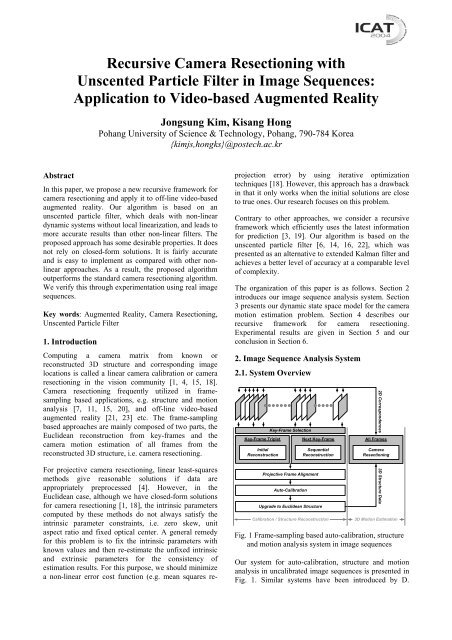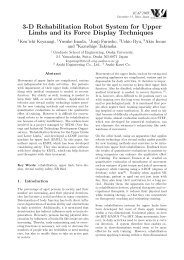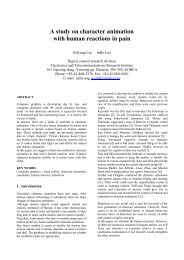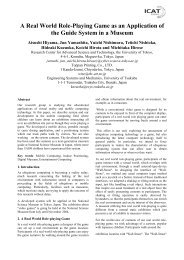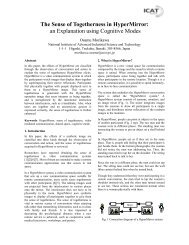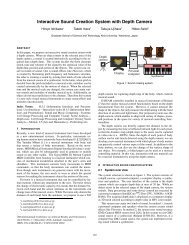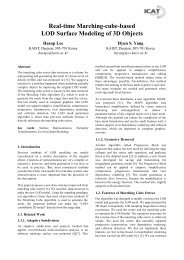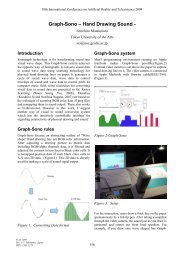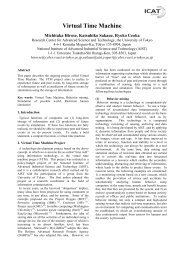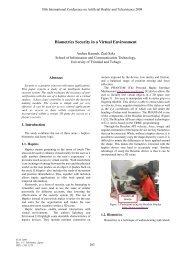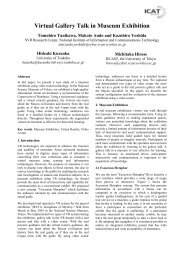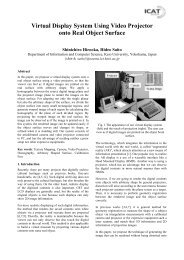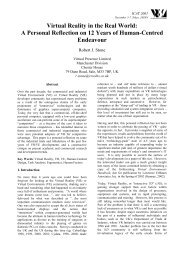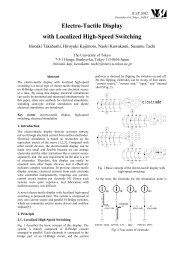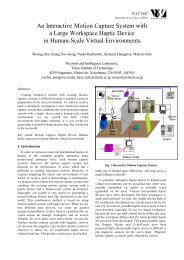Recursive Camera Resectioning with Unscented Particle Filter in ...
Recursive Camera Resectioning with Unscented Particle Filter in ...
Recursive Camera Resectioning with Unscented Particle Filter in ...
You also want an ePaper? Increase the reach of your titles
YUMPU automatically turns print PDFs into web optimized ePapers that Google loves.
<strong>Recursive</strong> <strong>Camera</strong> <strong>Resection<strong>in</strong>g</strong> <strong>with</strong><br />
<strong>Unscented</strong> <strong>Particle</strong> <strong>Filter</strong> <strong>in</strong> Image Sequences:<br />
Application to Video-based Augmented Reality<br />
Jongsung Kim, Kisang Hong<br />
Pohang University of Science & Technology, Pohang, 790-784 Korea<br />
{kimjs,hongks}@postech.ac.kr<br />
Abstract<br />
In this paper, we propose a new recursive framework for<br />
camera resection<strong>in</strong>g and apply it to off-l<strong>in</strong>e video-based<br />
augmented reality. Our algorithm is based on an<br />
unscented particle filter, which deals <strong>with</strong> non-l<strong>in</strong>ear<br />
dynamic systems <strong>with</strong>out local l<strong>in</strong>earization, and leads to<br />
more accurate results than other non-l<strong>in</strong>ear filters. The<br />
proposed approach has some desirable properties. It does<br />
not rely on closed-form solutions. It is fairly accurate<br />
and is easy to implement as compared <strong>with</strong> other nonl<strong>in</strong>ear<br />
approaches. As a result, the proposed algorithm<br />
outperforms the standard camera resection<strong>in</strong>g algorithm.<br />
We verify this through experimentation us<strong>in</strong>g real image<br />
sequences.<br />
Key words: Augmented Reality, <strong>Camera</strong> <strong>Resection<strong>in</strong>g</strong>,<br />
<strong>Unscented</strong> <strong>Particle</strong> <strong>Filter</strong><br />
1. Introduction<br />
Comput<strong>in</strong>g a camera matrix from known or<br />
reconstructed 3D structure and correspond<strong>in</strong>g image<br />
locations is called a l<strong>in</strong>ear camera calibration or camera<br />
resection<strong>in</strong>g <strong>in</strong> the vision community [1, 4, 15, 18].<br />
<strong>Camera</strong> resection<strong>in</strong>g frequently utilized <strong>in</strong> framesampl<strong>in</strong>g<br />
based applications, e.g. structure and motion<br />
analysis [7, 11, 15, 20], and off-l<strong>in</strong>e video-based<br />
augmented reality [21, 23] etc. The frame-sampl<strong>in</strong>g<br />
based approaches are ma<strong>in</strong>ly composed of two parts, the<br />
Euclidean reconstruction from key-frames and the<br />
camera motion estimation of all frames from the<br />
reconstructed 3D structure, i.e. camera resection<strong>in</strong>g.<br />
For projective camera resection<strong>in</strong>g, l<strong>in</strong>ear least-squares<br />
methods give reasonable solutions if data are<br />
appropriately preprocessed [4]. However, <strong>in</strong> the<br />
Euclidean case, although we have closed-form solutions<br />
for camera resection<strong>in</strong>g [1, 18], the <strong>in</strong>tr<strong>in</strong>sic parameters<br />
computed by these methods do not always satisfy the<br />
<strong>in</strong>tr<strong>in</strong>sic parameter constra<strong>in</strong>ts, i.e. zero skew, unit<br />
aspect ratio and fixed optical center. A general remedy<br />
for this problem is to fix the <strong>in</strong>tr<strong>in</strong>sic parameters <strong>with</strong><br />
known values and then re-estimate the unfixed <strong>in</strong>tr<strong>in</strong>sic<br />
and extr<strong>in</strong>sic parameters for the consistency of<br />
estimation results. For this purpose, we should m<strong>in</strong>imize<br />
a non-l<strong>in</strong>ear error cost function (e.g. mean squares reprojection<br />
error) by us<strong>in</strong>g iterative optimization<br />
techniques [18]. However, this approach has a drawback<br />
<strong>in</strong> that it only works when the <strong>in</strong>itial solutions are close<br />
to true ones. Our research focuses on this problem.<br />
Contrary to other approaches, we consider a recursive<br />
framework which efficiently uses the latest <strong>in</strong>formation<br />
for prediction [3, 19]. Our algorithm is based on the<br />
unscented particle filter [6, 14, 16, 22], which was<br />
presented as an alternative to extended Kalman filter and<br />
achieves a better level of accuracy at a comparable level<br />
of complexity.<br />
The organization of this paper is as follows. Section 2<br />
<strong>in</strong>troduces our image sequence analysis system. Section<br />
3 presents our dynamic state space model for the camera<br />
motion estimation problem. Section 4 describes our<br />
recursive framework for camera resection<strong>in</strong>g.<br />
Experimental results are given <strong>in</strong> Section 5 and our<br />
conclusion <strong>in</strong> Section 6.<br />
2. Image Sequence Analysis System<br />
2.1. System Overview<br />
Key-Frame Triplet<br />
Initial<br />
Reconstruction<br />
Key-Frame Selection<br />
Projective Frame Alignment<br />
Auto-Calibration<br />
Next Key-Frame<br />
Sequential<br />
Reconstruction<br />
Upgrade to Euclidean Structure<br />
Calibration / Structure Reconstruction<br />
2D Correspondences 3D Structure Data<br />
All Frames<br />
<strong>Camera</strong><br />
<strong>Resection<strong>in</strong>g</strong><br />
3D Motion Estimation<br />
Fig. 1 Frame-sampl<strong>in</strong>g based auto-calibration, structure<br />
and motion analysis system <strong>in</strong> image sequences<br />
Our system for auto-calibration, structure and motion<br />
analysis <strong>in</strong> uncalibrated image sequences is presented <strong>in</strong><br />
Fig. 1. Similar systems have been <strong>in</strong>troduced by D.
Nister [16] and B. Georgescu et al. [20]. Our system is<br />
composed of two ma<strong>in</strong> parts; Euclidean structure<br />
estimation from key-frames and motion estimation by<br />
camera resection<strong>in</strong>g.<br />
2.2. Auto-Calibration and Euclidean Structure<br />
Reconstruction from Key-Frames<br />
In our system, select<strong>in</strong>g and track<strong>in</strong>g image features<br />
from image sequences is conducted by the Kanade-<br />
Lucas-Tomasi algorithm [2]. To automatically select<br />
key-frames we use the frame decimation algorithm [16]<br />
or key-frame selection algorithms [21, 23]. In our<br />
experiments we manually select key-frames. From the<br />
first three key-frames, we reconstruct the <strong>in</strong>itial 3D<br />
structure and three projective cameras by us<strong>in</strong>g the<br />
trifocal tensor constra<strong>in</strong>t [15]. We sequentially merge the<br />
next key-frame to the first three key-frames us<strong>in</strong>g the<br />
reconstructed projective structure. After complet<strong>in</strong>g the<br />
projective reconstruction from key-frames <strong>in</strong> image<br />
sequences, we m<strong>in</strong>imize the estimation error <strong>with</strong> the<br />
projective bundle adjustment, and then we upgrade the<br />
projective reconstruction to the Euclidean reconstruction<br />
by us<strong>in</strong>g the auto-calibration technique. We apply the<br />
Euclidean bundle adjustment to m<strong>in</strong>imize the calibration<br />
error. Refer to Pollefeys et al. [10, 11] and Triggs et al.<br />
[12] for details on auto-calibration and bundleadjustment,<br />
respectively.<br />
2.3. 3D Motion Estimation of Mov<strong>in</strong>g <strong>Camera</strong> by<br />
<strong>Camera</strong> <strong>Resection<strong>in</strong>g</strong><br />
From the 2D correspondences and the 3D structure<br />
computed <strong>in</strong> the first step, we estimate the 3D motion of<br />
mov<strong>in</strong>g camera <strong>in</strong> all frames. This procedure is called<br />
l<strong>in</strong>ear calibration or camera resection<strong>in</strong>g. The estimated<br />
camera parameters are used <strong>in</strong> the off-l<strong>in</strong>e augmented<br />
reality system developed <strong>in</strong> our laboratory.<br />
L<strong>in</strong>ear and non-l<strong>in</strong>ear estimation techniques for camera<br />
<strong>in</strong>tr<strong>in</strong>sic and extr<strong>in</strong>sic parameters have been <strong>in</strong>troduced<br />
<strong>in</strong> many vision materials [1, 15, 18]. Most of<br />
conventional approaches are based on l<strong>in</strong>ear least<br />
squares methods. However, l<strong>in</strong>ear solutions are not<br />
adequate for the augmented reality system where<br />
estimated cameras should satisfy some constra<strong>in</strong>ts, i.e.<br />
zero skew, unit aspect ratio, and fixed optical center. In<br />
the previous work this problem has never been directly<br />
considered [21, 23]. A general solution for this problem<br />
is to fix the <strong>in</strong>tr<strong>in</strong>sic parameters <strong>with</strong> known values and<br />
then re-estimate the unfixed <strong>in</strong>tr<strong>in</strong>sic parameters and<br />
extr<strong>in</strong>sic parameters. For the consistency of the<br />
estimation results, we should reduce the estimation error<br />
aris<strong>in</strong>g from the bl<strong>in</strong>d parameter fix<strong>in</strong>g by us<strong>in</strong>g iterative<br />
optimization techniques [18]. However, this approach<br />
has a drawback that it works only when the l<strong>in</strong>ear<br />
solutions are close to true ones. Our camera resection<strong>in</strong>g<br />
algorithm solves this problem by us<strong>in</strong>g the state space<br />
model and the recursive estimation.<br />
3. Problem Formulation<br />
We adopt a dynamic state-space model <strong>with</strong> parameters<br />
to represent the camera motion. The global rotation<br />
Ω∈SO<br />
3 and the global translation T of the camera<br />
( )<br />
are def<strong>in</strong>ed as the system states, and written by<br />
x = { Ω,T}<br />
. (1)<br />
Associated to each motion Ω , T , there are timevary<strong>in</strong>g<br />
parameters, i.e. angular velocity ω , l<strong>in</strong>ear<br />
velocity V , angular acceleration ω , and l<strong>in</strong>ear<br />
acceleration V . We use θ as the notation for the system<br />
parameters, and def<strong>in</strong>e as<br />
1 N<br />
{ f, ωω , , V, V<br />
, ω<br />
, , X , , X }<br />
θ = Σ Σ … (2)<br />
where f is a focal length, Σ ω<br />
,<br />
V<br />
ΣV<br />
<br />
static parameters for<br />
the covariance matrix of ω , V , respectively, and<br />
1 N<br />
X ,…,<br />
X 3D po<strong>in</strong>ts of the static scene reconstructed <strong>in</strong><br />
the first step of our image sequence analysis system. The<br />
time evolution model for the system states and the<br />
system parameters is given by<br />
f<br />
t + 1<br />
= f t<br />
(3)<br />
() i () i<br />
X = t 1<br />
Xt<br />
i = +<br />
1, … , N<br />
ωt Ωt<br />
Ω<br />
t<br />
= log e e<br />
SO<br />
T<br />
+ 1 3<br />
( )(<br />
ˆ<br />
)<br />
(4)<br />
(5)<br />
=<br />
ˆ ωt<br />
t 1<br />
e T + + t<br />
V (6)<br />
t<br />
= + t+ 1 t t t<br />
N ( 0, Σ ω )<br />
+ 1<br />
= + ( 0, Σ )<br />
ω ω ω ω ∼ (7)<br />
V V V V ∼ N<br />
(8)<br />
t t t V<br />
where ˆω is the skew symmetric matrix of angular<br />
velocity ω , and log SO (<br />
the <strong>in</strong>verse of Rodrigues'<br />
3)<br />
formula [19]. The measurement equation is given by<br />
T<br />
( ) (<br />
y = x , y ,…, x , y = h x , θ ) + nt<br />
t t1 t1<br />
tn tn t t<br />
)<br />
(9)<br />
where the measurement noise nt ∼ N (0, Σ nt<br />
and h ( ⋅)<br />
is the 2 N vector of correspond<strong>in</strong>g non-l<strong>in</strong>ear equation<br />
of the perspective camera projection, def<strong>in</strong>ed by<br />
where<br />
1 2<br />
⎛ ⎡ () i<br />
() i<br />
X ′ ⎤ ⎡ ,<br />
T<br />
t<br />
X ′ ⎤ ⎞<br />
⎜<br />
,<br />
t ⎟<br />
x y = f<br />
⎣ ⎦<br />
f<br />
⎣ ⎦<br />
⎜ 3<br />
3 ⎟<br />
() i<br />
() i<br />
⎜ ⎡X<br />
′ ⎤ ⎡<br />
t<br />
X ′ ⎤ ⎟<br />
t<br />
⎝ ⎣ ⎦ ⎣ ⎦ ⎠<br />
() i () i<br />
( t t )<br />
() i Ωt<br />
() i<br />
t<br />
t<br />
t<br />
T<br />
(10)<br />
i<br />
X ′ = e X + T and [] ⋅ i th element. In our<br />
problem formulation, we assume that the camera<br />
<strong>in</strong>tr<strong>in</strong>sic parameters are fixed <strong>with</strong> known values.<br />
Contrary to the conventional approaches, this<br />
assumption makes no error <strong>in</strong> our recursive camera<br />
resection<strong>in</strong>g algorithm.
4. <strong>Recursive</strong> <strong>Camera</strong> <strong>Resection<strong>in</strong>g</strong><br />
4.1. Propagat<strong>in</strong>g Mean and Covariance of<br />
<strong>Camera</strong> System State by <strong>Unscented</strong> Kalman<br />
<strong>Filter</strong><br />
<strong>Unscented</strong> transform [6] is a method for propagat<strong>in</strong>g<br />
mean and covariance <strong>with</strong> second order accuracy <strong>in</strong> a<br />
nonl<strong>in</strong>ear system. This transform was applied to the<br />
extended Kalman filter and called as unscented Kalman<br />
filter (UKF) by E. A. Wan et al. [14]. We <strong>in</strong>clude Fig. 2<br />
to visually illustrate the idea of the unscented transform<br />
and to support the understand<strong>in</strong>g the UKF-based part of<br />
our algorithm. In this algorithm, the mean and the<br />
covariance of the n -dimensional state is represented<br />
<strong>with</strong> 2 n + 1 weighted samples, called sigma po<strong>in</strong>ts.<br />
mean<br />
Non-l<strong>in</strong>ear Transform<br />
y = h( x)<br />
true mean<br />
covariance<br />
true covariance<br />
L<strong>in</strong>earization (EKF)<br />
EKF mean<br />
y = h( x)<br />
T<br />
P = H P H<br />
y<br />
x<br />
EKF covariance<br />
sigma po<strong>in</strong>ts<br />
<strong>Unscented</strong> Transform<br />
Y = h X<br />
i<br />
UT mean<br />
( i)<br />
y = ∑ WY i i i<br />
P = W ( Y − )( Y − ) T<br />
y i i i<br />
y<br />
i<br />
y<br />
∑<br />
UT covariance<br />
transformed<br />
sigma po<strong>in</strong>ts<br />
Fig. 2 Mean and covariance propagation: non-l<strong>in</strong>ear<br />
transform (left), extended Kalman filter (center),<br />
unscented transform (right)<br />
Through UKF algorithm we predict the mean x UKF<br />
t<br />
and<br />
covariance<br />
x t<br />
UKF<br />
Σ t<br />
at time t of the camera system state<br />
<strong>in</strong> (1). The UKF-based prediction algorithm can be<br />
described <strong>in</strong> the follow<strong>in</strong>g way:<br />
2n + 1<br />
X ,…,<br />
X +<br />
(0) (2n<br />
1)<br />
Calculate sigma po<strong>in</strong>ts { } of the<br />
t−1 t−1<br />
camera system state us<strong>in</strong>g the mean and the covariance<br />
at time t −1 :<br />
X<br />
(0) (0)<br />
t−1 t−1<br />
( )<br />
= x W = k n+ k (11)<br />
(<br />
() i<br />
( ) )<br />
i<br />
( )<br />
(<br />
() i<br />
( ) ) ( )<br />
() i<br />
()<br />
X<br />
t−1 = x<br />
t−1+ n+ k Σ<br />
t−1 W = 1 2 n+<br />
k (12)<br />
X = x − n+ k Σ W = n+<br />
k (13)<br />
( i + n) ( i + n)<br />
t−1 t−1 t−1 12<br />
where ( A ) () i<br />
is i th s<strong>in</strong>gular vector of the matrix<br />
A and k = 2 and n = 6 .<br />
Predict the mean and the covariance of the system state<br />
from 2n +1sigma po<strong>in</strong>ts us<strong>in</strong>g the time evolution model<br />
<strong>in</strong> (3) ~ (8) (we denote a symbol g to represent the<br />
evolution model), and the measurement equation <strong>in</strong> (9):<br />
i<br />
( )<br />
X g X , θ i 1, …,2 + 1 (14)<br />
() i<br />
()<br />
tt | −1 =<br />
t−1 t<br />
= n<br />
2n+<br />
1<br />
() i () i<br />
tt | −1 = ∑ W Xtt<br />
| −1<br />
i=<br />
0<br />
x (15)<br />
( )( )<br />
2n+<br />
1<br />
xx () i () i () i<br />
T<br />
tt | −1 W Xtt | −1 tt | −1 Xtt | −1 tt | 1<br />
i=<br />
0<br />
Σ = ∑ −x −x −<br />
(16)<br />
Y<br />
() i<br />
( X<br />
− )<br />
= h θ + n (17)<br />
,<br />
tt | −1 tt | 1 t t<br />
2n+<br />
1<br />
() i () i<br />
tt | −1 = ∑ W Ytt<br />
| −1<br />
i=<br />
0<br />
y (18)<br />
Update the predicted mean and the predicted covariance<br />
by <strong>in</strong>novation <strong>in</strong>formation:<br />
( )( )<br />
2n+<br />
1<br />
yy () i () i () i<br />
T<br />
tt | −1 W Ytt | −1 tt | −1 Ytt | −1 tt | 1<br />
i=<br />
0<br />
Σ = ∑ −y −y −<br />
(19)<br />
( )( )<br />
2n+<br />
1<br />
xy () i () i () i<br />
T<br />
tt | −1 W Xtt | −1 tt | −1 Ytt | −1 tt | 1<br />
i=<br />
0<br />
Σ = ∑ −x −y −<br />
(20)<br />
xy<br />
K t t | t −1 t | t 1<br />
yy<br />
−<br />
( ) 1<br />
−<br />
K ( )<br />
=Σ Σ (21)<br />
x = x + y −y −<br />
UKF<br />
t t| t−1 t t t| t 1<br />
UKF xx yy T<br />
t t| t−1 t t| t−1<br />
t<br />
(22)<br />
Σ =Σ −K<br />
Σ K<br />
(23)<br />
This procedure enables to generate samples from the<br />
predicted modes of the proposal distribution, which is<br />
called UKF proposal distribution [16].<br />
4.2. Bayesian <strong>Filter</strong><strong>in</strong>g of <strong>Camera</strong> System State<br />
by <strong>Unscented</strong> <strong>Particle</strong> <strong>Filter</strong> <strong>with</strong> Independent<br />
Metropolis-Hast<strong>in</strong>gs Cha<strong>in</strong><br />
UKF Proposal<br />
<strong>Particle</strong> <strong>Filter</strong><br />
<strong>Unscented</strong> <strong>Particle</strong> <strong>Filter</strong><br />
Independent<br />
Independent<br />
Metropolis-Hast<strong>in</strong>gs<br />
Metropolis-Hast<strong>in</strong>gs<br />
Cha<strong>in</strong><br />
Cha<strong>in</strong><br />
Sample Draw<strong>in</strong>g<br />
Sample Draw<strong>in</strong>g<br />
UKF<br />
UKF<br />
Accept/Reject<br />
Accept/Reject<br />
<strong>Particle</strong>s<br />
<strong>Particle</strong>s<br />
Fig. 3 <strong>Unscented</strong> particle filter <strong>with</strong> <strong>in</strong>dependent<br />
Metropolis-Hast<strong>in</strong>gs cha<strong>in</strong> sampl<strong>in</strong>g<br />
In Fig. 3, we show the block diagram of our filter design<br />
for the Bayesian filter<strong>in</strong>g of camera system state.<br />
<strong>Unscented</strong> particle filter (UPF) [16] is a particle filter<br />
based on sequential importance sampl<strong>in</strong>g [8] and the<br />
unscented Kalman filter. R. van der Merwe et al. [14]<br />
showed that UPF outperforms standard particle filter<strong>in</strong>g<br />
and other non-l<strong>in</strong>ear filter<strong>in</strong>g methods.<br />
For dynamic systems, the importance proposal can be<br />
modeled <strong>with</strong> a mixture of Gaussian distributions and<br />
are obta<strong>in</strong>ed by a bank of unscented Kalman filters [22].<br />
Because a mov<strong>in</strong>g camera is a dynamic system, we adopt<br />
the Gaussian mixture proposal distribution. This<br />
approach allows for a reduction <strong>in</strong> the number of<br />
particles. Our importance proposal distribution, a<br />
mixture of M Gaussian distributions is given by
Select<br />
k<br />
J<br />
M<br />
( ) ( j ) ( ( j ), UKF ( j ), UKF<br />
x x0: −1 =<br />
−1<br />
x x , Σ ).<br />
∑<br />
g w N<br />
t t t t t t t<br />
j = 1<br />
(24)<br />
Draw<strong>in</strong>g a sample accord<strong>in</strong>g to the proposal <strong>in</strong> (24) has<br />
the follow<strong>in</strong>g four steps:<br />
Select J th component from the Gaussian mixture<br />
proposal distribution <strong>in</strong> (24) <strong>with</strong> probability<br />
proportional to the weight<strong>in</strong>g factor wt<br />
− 1<br />
, which is<br />
represented <strong>with</strong> the cumulative distribution function<br />
(CDF) given by<br />
J<br />
wt<br />
− 1<br />
j = 1<br />
( j)<br />
( )<br />
C J<br />
= ∑ .<br />
(25)<br />
( ),<br />
Predict the mean<br />
J UKF<br />
( ),<br />
x<br />
t<br />
and the covariance Σ J UKF<br />
t<br />
by<br />
the way described <strong>in</strong> Section 4.1<br />
Draw a sample accord<strong>in</strong>g to the proposal distribution<br />
written by<br />
g<br />
<strong>with</strong><br />
C( J)<br />
( )<br />
Propagate x and <strong>with</strong> UKF<br />
J1 k ( )<br />
t− Σ<br />
J1 k<br />
t −<br />
( J )<br />
Generate x k<br />
t <strong>with</strong><br />
k<br />
N x , Σ<br />
k<br />
( J ), UKF ( J ), UKF<br />
( t<br />
t )<br />
Compute the acceptance probability<br />
p<br />
( Jk<br />
) ,<br />
( J<br />
x x<br />
) k−1<br />
( )<br />
a t t<br />
Generate a Uniform (0,1)<br />
random variable U<br />
U ≤ p a<br />
YES<br />
( J )<br />
Accept x k<br />
t<br />
NO<br />
Reta<strong>in</strong><br />
( J k −1<br />
)<br />
t<br />
( 0: − 1 ) = N( , Σ )<br />
x x x x (26)<br />
( ) ( ), ( ), t t t t t t<br />
Accept or Reject the sample us<strong>in</strong>g rejection criteria.<br />
This procedure is repeatedly conducted until the<br />
generated sample is accepted. This algorithm is called as<br />
rejection algorithm. It is well-acknowledged that this<br />
algorithm is restrictive and <strong>in</strong>efficient [8]. For example,<br />
<strong>in</strong> rejection algorithm we should repeat the sampl<strong>in</strong>g<br />
procedure until one sample is accepted. To improve the<br />
efficiency and the convergence of the sampl<strong>in</strong>g<br />
x<br />
k ≥ k th<br />
YES<br />
<strong>Unscented</strong><br />
Kalman <strong>Filter</strong><br />
Fig. 4 Independent Metropolis-Hast<strong>in</strong>g Cha<strong>in</strong> algorithm<br />
<strong>in</strong>corporated <strong>with</strong> unscented Kalman filter<br />
NO<br />
algorithm, we adopt <strong>in</strong>dependent Metropolis-Hast<strong>in</strong>gs<br />
cha<strong>in</strong> (IMHC) [8]:<br />
Generate a sample X from g ( ⋅ )<br />
Generate a Uniform (0, 1) random variable U<br />
⎡ ( ) ( )<br />
If m<strong>in</strong> 1, f X g X ′ ⎤<br />
U ≤ ⎢ ⎥ accept X<br />
f ( X′<br />
) g( X)<br />
⎢⎣<br />
else set X equal to X ′<br />
where X ′ is the previous value of X . This method has<br />
many preferable properties. It achieves re-sampl<strong>in</strong>g<br />
effect automatically and also avoids weight estimation.<br />
Re-sampl<strong>in</strong>g is necessary to evolve the system for time<br />
t to t + 1 and to prevent the proposal distribution from<br />
becom<strong>in</strong>g skewed. Our sampl<strong>in</strong>g procedure is illustrated<br />
<strong>in</strong> Fig. 4. Through this procedure, we generate M<br />
samples.<br />
We summarize the ma<strong>in</strong> part of our recursive camera<br />
resection<strong>in</strong>g algorithm:<br />
<strong>Recursive</strong> <strong>Camera</strong> <strong>Resection<strong>in</strong>g</strong> Algorithm<br />
Iterate for J = 1, …,<br />
M<br />
Draw<br />
g<br />
X<br />
t<br />
( J )<br />
t<br />
= x from<br />
⎥⎦<br />
( 0: − 1 ) = N( , Σ )<br />
x x x x (27)<br />
( ) ( ), ( ), t t t t t t<br />
by UKF and IMHC approach where the<br />
rejection probability can be computed as<br />
p<br />
⎛ f<br />
, = m<strong>in</strong>⎜1,<br />
⎜ f<br />
⎝<br />
( J ) ( Jk<br />
)<br />
( x x )<br />
a t t<br />
and the likelihood function as<br />
f<br />
( J )<br />
( y x , θ )<br />
Jk<br />
( y x , θ )<br />
w ⎞<br />
⎟,<br />
w ⎟<br />
⎠<br />
(28)<br />
( Jk<br />
)<br />
t t t t−1<br />
( ) ( J )<br />
t t t t−1<br />
{ }<br />
T −1<br />
( yxθ , ) = exp −( y−y) Σn<br />
( y−y)<br />
Compute the <strong>in</strong>cremental weight<br />
. (29)<br />
( J) ( J)<br />
( J) ( J)<br />
ut = f ( yt xt , θt) q( xt x<br />
t−1<br />
),<br />
( )<br />
t t t 1<br />
( J ) J ( J )<br />
and let w = u w −<br />
.<br />
( J )<br />
Normalize so that ∑ w = 1 .<br />
j t<br />
Estimate the mode of the system state as like<br />
M<br />
( J ) ( J )<br />
t t⎤ ≈ wt t<br />
J = 1<br />
(30)<br />
E⎡⎣X Y ⎦ ∑ x . (31)
Fig. 6 Video augmentation of bound<strong>in</strong>g box: the first<br />
frame (top), the last frame (bottom)<br />
Fig. 5 Comparison of accumulated estimation error:<br />
camera translation (top), camera rotation (bottom)<br />
5. Experiments<br />
We tested our algorithm on an image sequence of 90<br />
frames. Three key-frames were selected manually for<br />
this experiment. 3D structure po<strong>in</strong>ts, image<br />
correspondences and camera <strong>in</strong>tr<strong>in</strong>sic parameters were<br />
computed by our system presented <strong>in</strong> Fig. 1. We<br />
acquired about 209 features at each frame, 706 3D scene<br />
po<strong>in</strong>ts, and the estimated focal length is 1001. We used<br />
30 particles for UPF, i.e. M =30, 5 iterations for IMHC,<br />
i.e. =5. We experimentally determ<strong>in</strong>ed the values of<br />
k th<br />
system parameters as<br />
σ n<br />
=0.005, assum<strong>in</strong>g that<br />
σ ω<br />
=0.0005, σ<br />
v <br />
Σ 2 ω<br />
=σ ωI<br />
,<br />
v<br />
=0.003 and<br />
Σ =σ and<br />
2<br />
I v<br />
Σ =σ 2 n n<br />
I . Initial means for camera system state were<br />
all zero, i.e. (1) ( M<br />
x<br />
)<br />
0<br />
= … = x0<br />
= 0 but <strong>in</strong>itial covariance<br />
matrices were <strong>in</strong>itialized as<br />
(1) (1)<br />
Σ<br />
0<br />
= … =Σ<br />
0<br />
= diag ( Σ ω<br />
Σv<br />
) . In Figs. 5 and 8, we<br />
compared our method <strong>with</strong> the standard method<br />
described <strong>in</strong> Section 2, the EKF-based method [3] and<br />
the non-l<strong>in</strong>ear method [18]. The estimation error<br />
depicted <strong>in</strong> Fig. 5 is the absolute difference of the<br />
Fig. 7 Video augmentation of graphic object: the first<br />
frame (top), the last frame (bottom)<br />
estimated values between the non-l<strong>in</strong>ear method and<br />
other methods.<br />
In Figs. 6 and 7, we illustrated the video augmentation<br />
results to show that our camera resection<strong>in</strong>g algorithm<br />
was successfully applied to augmented reality. In Figs. 5<br />
and 8, we can see that our method outperforms the
standard method and the EKF-based method, and gives<br />
results comparable to the non-l<strong>in</strong>ear method.<br />
Root-Mean-Squares Error [log scale]<br />
Standard Method<br />
(zero skew,<br />
unit aspect ratio,<br />
fixed optical center)<br />
EKF-based Method<br />
Non-l<strong>in</strong>ear Method<br />
Re-projection Error<br />
Proposed Method<br />
Frame<br />
Fig. 8 Comparison of re-projection error: standard<br />
method (red), EKF-based method (green), non-l<strong>in</strong>ear<br />
method (magenta), proposed method (blue)<br />
7. A. W. Fitzgibbon and A. Zisserman, " Automatic<br />
<strong>Camera</strong> Recovery for Closed and Open Image<br />
Sequences, " In Proc. ECCV, pp.311-326, 1998.<br />
8. J. S. Liu and R. Chen, " Sequential Monte Carlo<br />
Methods for Dynamic Systems," Journal of the<br />
American Statistical Association 93: 1032-1044, 1998.<br />
9. P. Torr, A. Fitzgibbon and A. Zisserman, " The<br />
Problem of Degeneracy <strong>in</strong> Structure and Motion<br />
Recovery from Uncalibrated Image Sequences," Int’l<br />
Journal of Computer Vision, vo1.32, no.1, pp.27-44,<br />
1999.<br />
10. M. Pollefeys, R. Koch, and L. Van Gool, " Self-<br />
Calibration and Metric Reconstruction <strong>in</strong> spite of<br />
Vary<strong>in</strong>g and Unknown Internal <strong>Camera</strong> Parameters,"<br />
Int’l Journal of Computer Vision 32(1):7-25, 1999.<br />
11. M. Pollefeys, " Tutorial on 3D Model<strong>in</strong>g from<br />
Images," ECCV, 2000.<br />
12. B. Triggs, P. McLauchlan, R. Hartley and A.<br />
Fitzgibbon, " Bundle Adjustment - A Modern<br />
Systhesis," 2000, In Vision Algorithms: Theory and<br />
Practice, LNCS, pp. 298-375, 2000.<br />
6. Conclusion 13. G. Simon, A. Fitzgibbon, and A. Zisserman, "<br />
Markerless Track<strong>in</strong>g us<strong>in</strong>g Planar Structures <strong>in</strong> the<br />
We proposed a new recursive framework for camera<br />
Scene," Proc. In Proc. ISAR, 2000.<br />
resection<strong>in</strong>g. The proposed framework is based on a<br />
14. E. A. Wan and R. van der Merwe, " The <strong>Unscented</strong><br />
unscented particle filter <strong>with</strong> <strong>in</strong>dependent Matropolis-<br />
Kalman <strong>Filter</strong> for Nonl<strong>in</strong>ear Estimation," In Proc.<br />
Hast<strong>in</strong>gs cha<strong>in</strong>. This algorithm enables the propagation<br />
Symposium 2000 on Adaptive Systems for Signal<br />
of the mean and the covariance of the previous camera<br />
Process<strong>in</strong>g, Communication and Control (AS-SPC),<br />
system state <strong>with</strong> second order accuracy. In this<br />
2000.<br />
framework, the proposal distribution is a mixture of a<br />
15. R. Hartley and A. Zisserman, " Multiple View<br />
Gaussian distribution. This makes it possible to use a<br />
Geometry <strong>in</strong> Computer Vision," Cambrige Univ. Press,<br />
small number of particles. To efficiently generate<br />
2000.<br />
samples from the proposal, we use an <strong>in</strong>dependent<br />
16. D. Nister, " Frame Decimation for Structure and<br />
Matropolis-Hast<strong>in</strong>gs cha<strong>in</strong> sampl<strong>in</strong>g algorithm. As a<br />
Motion," In Proc. SMILE 2000, LNCS, vol.2018, pp.17-<br />
result, the proposed algorithm gives results comparable<br />
34, 2001.<br />
to non-l<strong>in</strong>ear methods. It does not rely on erroneous<br />
17. R. van der Merwe, N. de Freitas, A. Doucet, and E.<br />
closed-form solutions. Experimentally, we showed that<br />
Wan, " The <strong>Unscented</strong> <strong>Particle</strong> <strong>Filter</strong>," In Proc. NIPS,<br />
our algorithm outperforms the standard camera<br />
2001.<br />
resection<strong>in</strong>g algorithm.<br />
18. D. A. Forsyth and J. Ponce, " Computer Vision: A<br />
References<br />
1. O. Faugeras, " Three Dimensional Computer Vision,"<br />
MIT Press, pp.52-58, 1993.<br />
2. J. Shi and C. Tomasi, " Good Features to Track," In<br />
Proc. CVPR, pp.593-600, 1994.<br />
3. A. Azerbayejani and A. Pentland, " <strong>Recursive</strong><br />
Estimation of Motion, Structure, and Focal Length,"<br />
IEEE Trans. on PAMI, vol.17, no.6, 1995.<br />
4. R. Hartley, " In Defence of the 8-Po<strong>in</strong>t Algorithm," In<br />
Proc. ICCV, pp.1064-1070, 1995.<br />
5. P. Beardsley, P. Torr and A. Zisserman, " 3D Model<br />
Acquisition from Extended Image Sequences," In Proc.<br />
ECCV, pp.683-695, 1995.<br />
6. J. Julier and J. K. Uhlman, "A New Extension of the<br />
Kalman <strong>Filter</strong> to Nonl<strong>in</strong>ear System," In Proc. Of<br />
AeroSense: The Int. Symbosium on Aerospace/Defence<br />
Sens<strong>in</strong>g, Simulation and Controls, Orlando, Florida,<br />
1997.<br />
Modern Approach, " Prentice Hall, 2002.<br />
19. A. Chiuso, P. Favaro, H. J<strong>in</strong> and S. Soatto, "<br />
Structure from Motion Causally Integrated Over Time,"<br />
IEEE Trans. on PAMI, Vol.24, No.4, 2002.<br />
20. B. Georgescu and P. Meer, " Balanced Recovery of<br />
3D Structure and <strong>Camera</strong> Motion from Uncalibrated<br />
Image Sequences, " LNCS 2351, pp.294-308, 2002.<br />
21. S. Gibson, J. Cook, T. Howard, R. Hubbold and D.<br />
Oram, " Accurate <strong>Camera</strong> Calibration for Off-l<strong>in</strong>e,<br />
Video-based Augmented Reality," In Proc. IEEE and<br />
ACM ISMAR, 2002.<br />
22. R. van der Merwe and E. Wan, " Gaussian Mixture<br />
Sigma-Po<strong>in</strong>t <strong>Particle</strong> <strong>Filter</strong>s for Sequential Probabilistic<br />
Inference <strong>in</strong> Dynamic State-Space Models," In Proc.<br />
Int’l Conf. on Acoustics, Speech and Signal Process<strong>in</strong>g<br />
(ICASSP), 2003.<br />
23. J. Seo, S. Kim, C. Jho, and H. Hong, " 3D<br />
Estimation and Keyframe selection for Mach Move," In<br />
Proc. of ITC-CSCC, 2003.


